We had never seen so many people together in Castelnuovo Magra. And even the municipal administration experienced the same feeling last night. So, accomplices of the pleasant summer atmosphere, the fascinating beauty of this Ligurian village a few kilometers from the border with Tuscany, its centuries of history (a certain Dante Alighieri also stopped here), the evocative view over the Lunense plain, and the passion for photography of the hundreds of people who, almost jubilant, filled the alleys of the village, the lectio magistralis given yesterday by Steve McCurry under the towers of the Castle of the Bishops of Luni, was an outstanding success. A wonderful evening, under a clear and starry sky, based on photography, art, history, passion. These are evenings that don’t happen often ... and so we were there, attentive from the first to the last second, to grasp the essence of the art of Steve McCurry, one of the world’s greatest photographers, who was acclaimed at the end by the audience almost like a rock star. Reconstructing an hour and a half of speeches, which also saw a strong participation of a very interested audience, is not easy, but we want to share with you the highlights of the speech that Steve McCurry gave in Castelnuovo Magra in Querciola Square. The result is some interesting “pills” that allow us to investigate some aspects of his art. Enjoy reading!
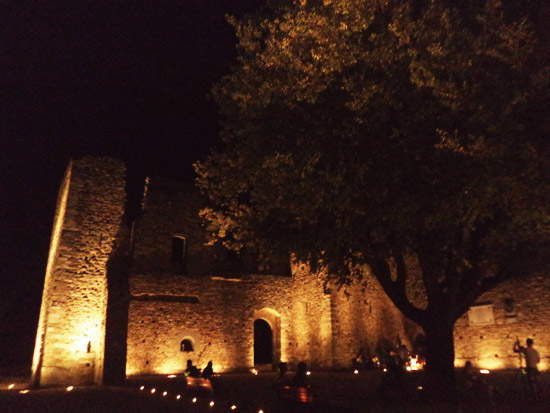 |
| The beautiful setting of Steve McCurry’s lectio magistralis: the Castle of the Bishops of Luni in Castelnuovo Magra |
The relationship with Elliott Erwitt
Elliott Erwitt began photographing seventy years ago: for me he has always been an important point of reference, I have always considered him a sort of guide, a master, and today I am lucky enough to consider myself his colleague as well as a good friend of his(nda: during the evening, Steve McCurry called Elliott Erwitt “live” and made sure that we in the audience gave him our warm greetings). What differentiates us lies in the fact that he, having started photography when color images did not exist, has always been tied to black-and-white photography, the one he started working with... I, on the other hand, started right away with color images. I don’t think black and white photos are better than color photos or vice versa, they are simply two different ways of working. However, I prefer the color photo because the world around us is in color, so based on my view, a color photo allows you to represent the world perhaps more accurately. One thing about Elliott that has been an inspiration to me is his photography of animals: he has published many books on dogs, for example. Here, I am fascinated by dogs and animals in general, although I have made fewer photographs in this area than Elliott but, again, his photographs of dogs have given me a lot of inspiration.
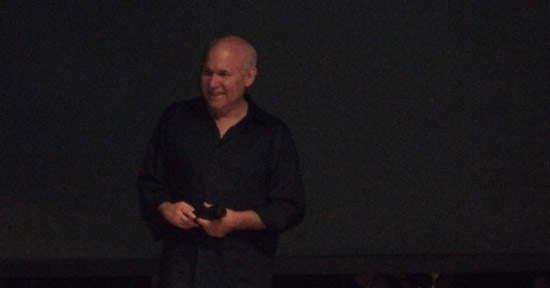 |
| Steve McCurry during one of the stages of his talk in Castelnuovo Magra |
The key to photography: observation
Photography comes from observations of the world around us, what we see, how people relate to each other ... in short, observation is the key to everything. It’s about exploring what we have around us, it’s about getting lost in the moment. That’s it, I think there is something magical that comes when you stop and observe. That’s where the best photos are born. If you find something beautiful, something worthy, don’t let it slip away: stop and stare at it. The most exciting moments often arise from chance encounters. Of course, for a good photograph it is obvious that it is important to find good colors, a harmony, the right rhythm: but it is also true that all this can be born even in the brief space of a moment, and it is our “task” to capture it as best we can.
Relationships with portrait subjects
Most of the people I portrayed in my photographs, I met during encounters that lasted very little, so I did not have time to deepen some sort of relationship with them other than the empathic one related to the image I was taking. That’s where a relationship comes in that is made up of . momentary chemistry, of connections that come about instantly, but these are still, in the vast majority of cases, relationships that are very short-lived. Sometimes excellent images can be taken even with a very short-lived encounter. It is up to the photographer to capture the depth andintensity of these very short relationships.
The story behind a photograph
A beautiful, interesting photograph, a successful photograph, is one that has a story behind it. When I take photographs, I always try to tell stories. That’s why I have been in India very often, and India is one of the main places I have traveled and photographed: there are interesting situations there, people, relationships are cultivated that lead to the telling of beautiful stories. However, one of the most important lessons I’ve learned is that the best photos come about when you’re traveling. At least, in my case the best photos were born while I was on my way to a destination. And then, one of the most important things I’ve learned from working with big magazines is to get to the gist of the story you’re telling. As mentioned, every photograph tells a story, and the photographer’s job is to represent the main moment of the story he or she is telling. Behind a photograph there is always a story, although I have to say that often what an observer imagines does not correspond to what is behind the photograph. On the contrary, often the imagination of the observer is able to create much more interesting stories than the actual photograph. Yes, sometimes reality is a little bit boring. And so it’s always nice to be able to imagine what lies behind a photograph -- and often it’s also nice to stop there, without investigating further.
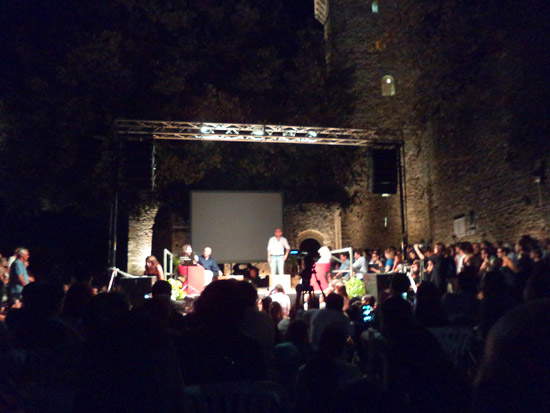 |
| The stage and the audience |
A life on the road
When I was working for a small newspaper in Pennsylvania, I would never have thought that I would one day work for National Geographic and thus have the opportunity to travel and work around the world-that’s it, life on the road is really very fulfilling, and so in addition to being happy with how my life has turned out, I will always have something to be grateful for. Because I cannot think of a better way to spend my life than traveling and photographing. I decided to start traveling when I was 19 years old, when I was still a student: since then I have never stopped, and I have no regrets. Sometimes I like to associate my life with the image of a hamster inside a wheel, spinning all the time and never stopping.
The importance of the team
You cannot underestimate the fact that you work in a good team, which should include not only the assistants who help you during the photographic work, but also those people who help you with practical matters. This becomes crucial especially when you work in war zones, or otherwise difficult areas-I was, for example, in Afghanistan or Iraq during the Gulf War. And there you need to move shrewdly: the people who work with you have your life in their hands.
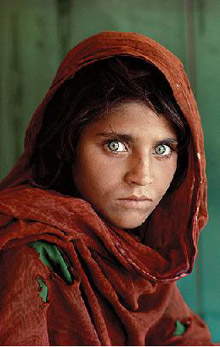 |
| The celebrated Afghan Girl. Credits |
The medium with which to take the images
The medium with which we take a photograph is not important. Often some of the best pictures that are taken are taken with a cell phone. I myself have professional photographer friends who do very serious work using only a cell phone. In short, I don’t think the camera in your hands is the most important thing when you take a photograph.
The photograph as a document
What the photographer wants is for the photograph to reflect what you saw. Especially when it comes to taking journalistic photos: in this case, creating artifact photos or, even worse, fakes, also becomes a very bad practice. It should not be done. The photo must document reality. Here, this is an aspect of photography that I love very much, because by taking pictures I feel a kind of witness to history. I want to be part of history, and photography is documenting what has been. That’s why I’m working a lot on Cuba now--first because, although it’s close to us Americans, we don’t have a deep perception of it and then precisely because of the fact that this nation is experiencing major changes that I think will transform the island in the near future. And I want to document these transformations.
The Afghan Girl
Yes, the Afghan Girl is one of my most successful photographs. What was it like to meet again with Sharbat Gula, the girl in the photograph, 20 years later? Well ... it was a powerfully emotional experience. Both of us had changed quite a bit, I had met and photographed her that she was 12 years old and I met her that she was 30 years old... it’s clear that I expected to find her changed, of course, but the emotion was really strong. And still we were really very pleased to meet again. And do you know why? Because if we met again almost twenty years later, it means that both of us were still alive.
The photographs on display
When you finish a work, there will be photos that you will remain attached to, photos that, in short, stick in your head. That’s it: the photographs I exhibit are the ones that stay in my head.
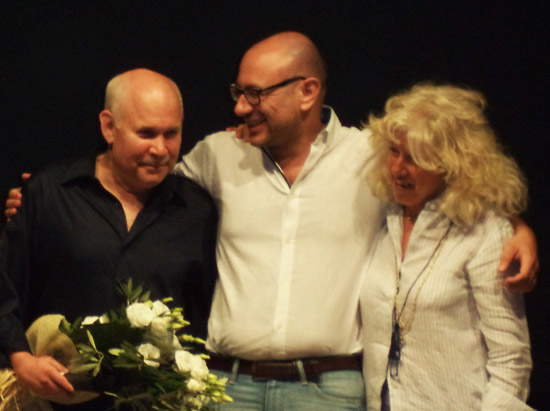 |
| Steve McCurry, the mayor of Castelnuovo Magra Daniele Montebello, and the curator of Elliott Erwitt’s Icons exhibition underway at the Castello dei Vescovi, Biba Giacchetti |
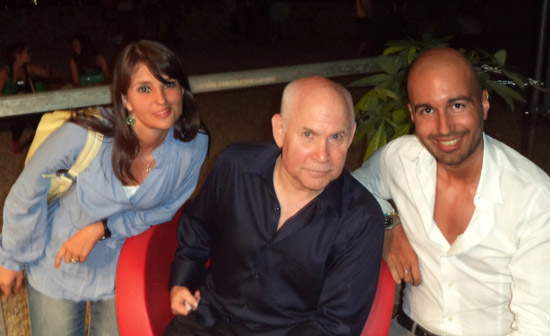 |
| Ilaria and Federico from Finestre Sull’Arte with Steve McCurry |
Warning: the translation into English of the original Italian article was created using automatic tools. We undertake to review all articles, but we do not guarantee the total absence of inaccuracies in the translation due to the program. You can find the original by clicking on the ITA button. If you find any mistake,please contact us.